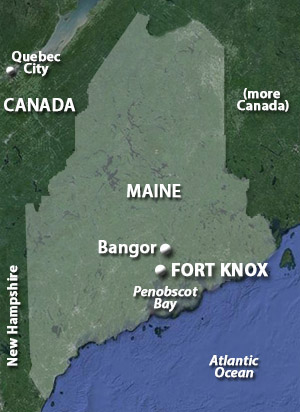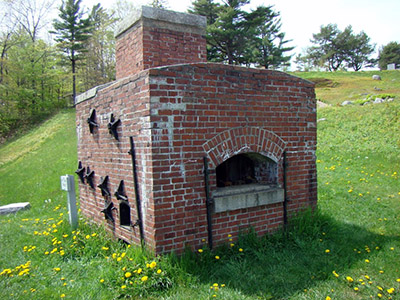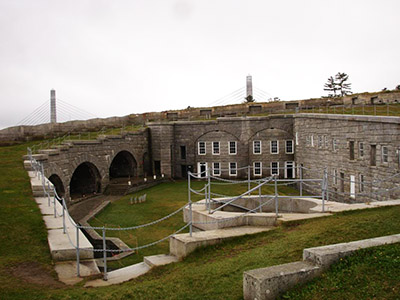 |
Fort Knox
Prospect, Maine, USA
|
|
 |
Constructed: 1844-1869
Used by: USA
Conflicts in which it participated:
None
|
The name Fort Knox is universally associated with gold bullion and the James Bond movie Goldfinger (1964). The Fort Knox in Kentucky scarcely even deserves the title of "fort," as it is, more precisely, a camp and depository for America's gold reserves. The Fort Knox to which this page is dedicated is a true fort, a granite monster built to defend something much more precious than Gold: Bangor, Maine.
The state of Maine did not fare well during America's first two wars. The American Revolutionary War (1775-1783) saw Great Britain capturing all of Maine east of the Penobscot River, renaming it New Ireland, and then successfully defending it against a 44-ship American force. The Penobscot Expedition of 1779 involved over 1,000 US Marines and militiamen (and artillery commanded by Paul Revere (1734-1818)), setting out in July of 1779 to dislodge the British at Fort George near the town of Castine. |
 |
 |
|
The American sea and land forces proved unable to coordinate their efforts, and the resulting debacle, including the destruction of all but one ship of the American fleet, produced the worst US naval defeat until that at Pearl Harbor in 1941.
The British sailed back up the Penobscot in August of 1814, as it turned out they were completely serious about this New Ireland business. Bangor was occupied and sacked, and it wasn't until the Treaty of Ghent (December 24, 1814) ended the War of 1812 that the British were finally convinced to leave Maine, their dream of a faraway place to stick all of their unruly (and frequently merrily intoxicated) Irishmen dashed.
|
|
 |
Maine became the 23rd US state in 1820. One of its first priorities was to figure out a way to prevent the Royal Navy from sailing up the Penobscot yet again. Congress agreed that a fort should be built on the Penobscot in 1825, but didn't get around to actually providing any money for this purpose for almost 20 years.
The Aroostook War of 1838-1839, a relatively gentle dispute betwixt the US and Great Britain regarding the border between Maine and British Colombia, reinforced the need for something of a solid defensive nature on the Penobscot. |
|
|
Once the young United States finally got its notional fort-ducks in a row, none other than fortification superstar Joseph Totten (1788-1864) was called upon to design the not-particularly-starrish Fort Knox. The fort was named for Henry Knox (1750-1806), who served as an artillery officer in the Continental Army in the American Revolutionary War, and later served as the United States' first Secretary of War. Knox had been born and raised in Boston, but retired to Thomaston, Maine.
|
The early stages of Fort Knox' construction was overseen by Brevet Major Isaac Stevens (1818-1862). In order to get some guns covering the river as quickly as possible, Stevens first concentrated on the fort's two water batteries, designed to mount 32-pounder smoothbore cannon, each battery with its own hot shot furnace.
The hot shot furnace, designed to heat solid shot to a state of red-hotness so as to instantly plunge any enemy ships struck with such projectiles into an unquenchable fire, were built at many US coastal forts of this era. Not a single one was ever put to practical use against a wooden-hulled foe, but they seemed like an excellent idea at the time.
|
 |
 One of Fort Knox' two hot shot furnaces: One of Fort Knox' two hot shot furnaces:
A well-intentioned (and very attractive) waste of time. |
|
Funding for Fort Knox continued at a trickle. Work didn't begin on the actual fort part of Fort Knox until 1853, with granite mined from nearby Mount Waldo in Frankfort, Maine. Fort Knox was built to mount a total of 135 guns, but no more than 74 cannon ever made it there. Click on this page's main image at the top for a full view of Fort Knox and its outlying batteries!
By the start of the US Civil War (1861-1865), Fort Knox was still unfinished, and its two water batteries remained unarmed: Constructed as they were in the 1840's, they were designed to mount guns that were ridiculously inadequate to stand against anything that might steam towards them in a threatening manner in the futuristic 1860's.
|
 The interior of Fort Knox, with the Penobscot River Bridge Observatory peeking up behind |
 |
Captain Thomas Casey (1831-1896) took over the construction of Fort Knox in August of 1862. Under his supervision, the outlying batteries were reconfigured to mount around fifty 10", and three 15", Rodman Guns. Casey never got the satisfaction of finishing Fort Knox, but he did go on to construct the Washington Monument in the 1880's.
The upper level of the fort, the terreplein, was built to mount 30 guns: This section was completed in 1864, but never armed. The lower level of Fort Knox comprises a series of casemates intended to house 23 heavier guns, though only fourteen 10" Rodmans were ever mounted therein...but the fort was never really finished. Work ceased in 1869. |
|
|
Though this may have been a little sad, it was by no means unusual. Many American starforts were conceived and built in an era when military technology was in a state of flux: Things were advancing so rapidly that a fort designed in the mid-19th century stood no chance of being anything near state-of-the-art ten years later...and a starfort often took longer than ten years to construct. Had the new state of Maine been able to wave its furry arms in 1825 and make a starfort poof supernaturally into being at that moment, it would have been supernaturally armed with death rays and magical flying narwahls anyway, so they wouldn't have even needed a pseudo-starfort.
|
While Fort Knox was never used for its intended purpose of vanquishing vast British invasion fleets, it did house troops on two occasions: During the US Civil War, small numbers of Maine volunteers lived at the fort until they were sent south to shoot at dudes in grey, and a Connecticut regiment manned the fort's walls during the Spanish-American War (1898), lest the wicked Spanish take an unhealthy interest in Bangor.
After that conflict, Fort Knox was left in the hands of a single caretaker sergeant.
|
 |
|
|
That caretaker continued his rounds until at least the end of 1916, watching over Rodman Guns that would have been the source of great levity to any modern European fighting ship that happened by. Fort Knox was declared to be excess of the federal government's needs in 1923, and the state of Maine purchased the fort and its 125-acre grounds for $2,121.
Fort Knox was named a US National Historic Landmark in 1970: Thank you, 37th US President Richard Nixon (1913-1994)!
|
|
|
|
|
|
 |




